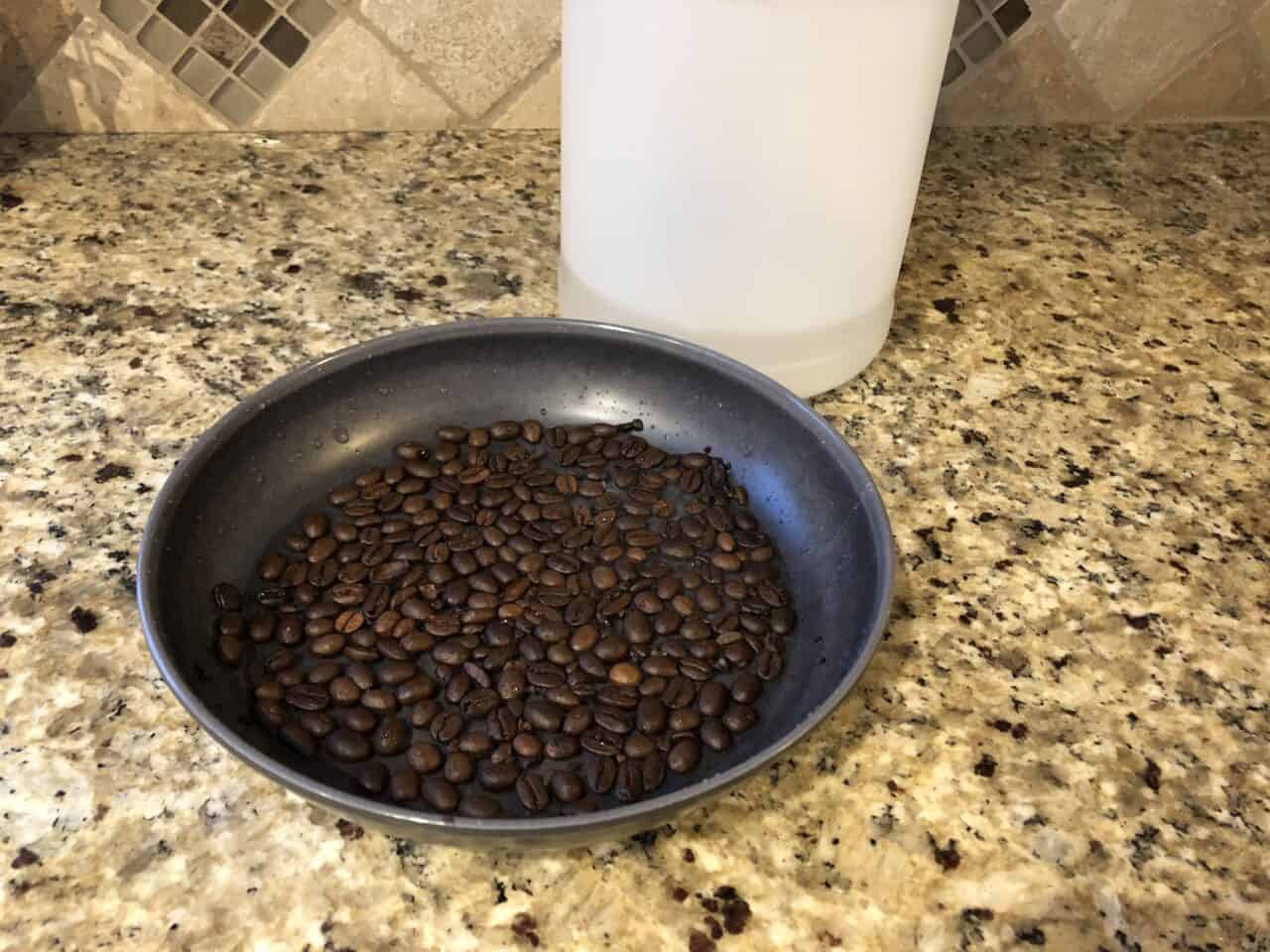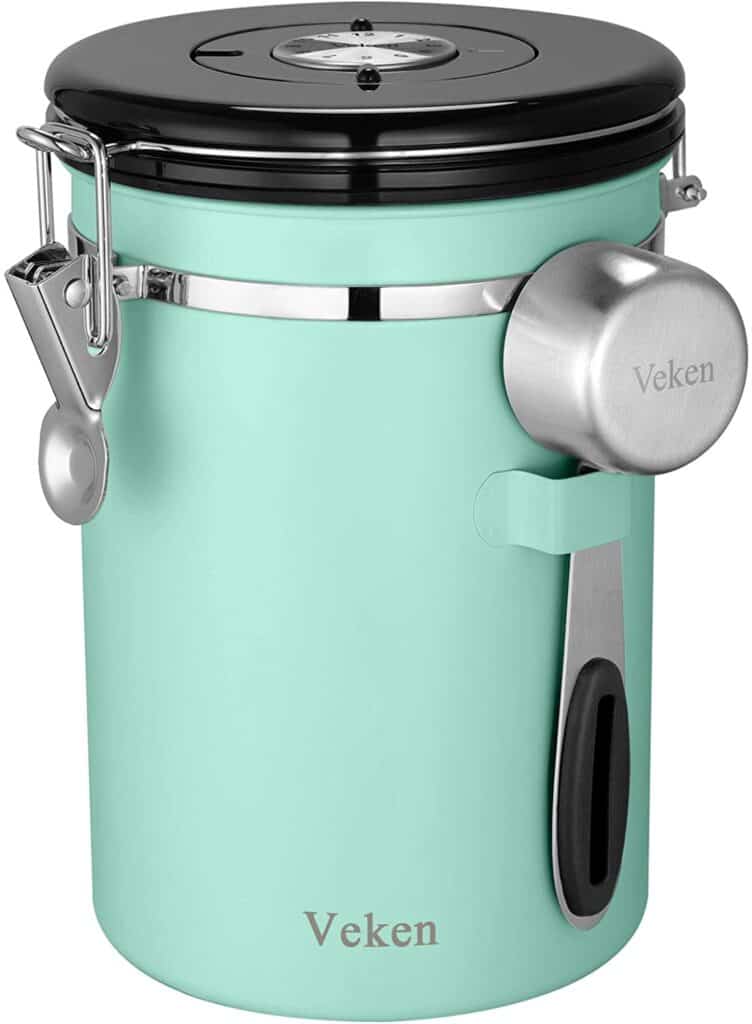To say we love coffee might be an understatement. We drink it by the gallons and store it by the pounds.
Now, I stock up on coffee just as much as the next guy, but you should make sure not to tuck away too much at once. Not only does coffee lose flavor and richness after being dormant in storage, but you also run the risk of developing mold and other harmful toxins.
As much of a hot commodity coffee is, it’s easy to forget that it’s still simply produced.
Coffee is just as vulnerable to invasive elements as all other perishable items. The nitrogen and natural oils encourage mold growth more than other produce items.
Small amounts of molds and mycotoxins are found in some coffee beans. Don’t let this denture you from enjoying your coffee. Typically, there isn’t enough to harm you.
By following simple steps and advice, you can side-step this common issue without sacrificing any of that precious java.
Why Does Mold Form on Coffee?

As I said, coffee is an organic substance that falls prey to outside contaminants, just like any vegetable or fruit.
If even a single bean is infected with mold, it will quickly spread to the rest of the batch.
It reminds me a lot, like when strawberries have that white fuzz.
Keeping large batches of coffee beans (mass producers) free from mold spores is next to impossible. Mold can release millions, even billions of spores into a given area.
High volumes of beans being dried out over large parts of land make them extra susceptible. It provides the spores plenty of surface area to land and imbeds themselves. This seems to be the case as more and more Americans drink coffee every year. High demand for a high yield.
Coffee Research (coffeeresearch) found that 80% of Americans indulge in daily coffee. Since coffee is being harvested in larger quantities, up to 45% of it contains potential mold spores.

The type of fermentation process, length of initial storage, and materials were stored vital roles in its preservation.
It’s not always obviously noticeable. If your freshly roasted coffee beans have a very bitter taste to them, they might be moldy.
It usually takes between 48 and 72 hours to develop fully, but conditions may vary.
Mold might also grow if the dry coffee is exposed to moisture. Storing coffee beans/grounds in an airtight, waterproof container is coffee storage 101. If you’re looking for an airtight coffee container, check out the Veken Coffee Canister.
Coffee is already packed with natural oils, essential nutrients, and even nitrogen. These ingredients will easily and effectively harbor life in the form of mold.
In fact, folks have discovered that coffee makes an excellent fertilizer! It even helps with healthy compost. No wonder mold loves coffee so much! If you’d like to read further about this check out our article about, Are Coffee Filters Compostable?
Coffee also has acidic properties ideal for mold. The average pH balance of coffee is between 5.2 to 6.9. Mold requires a pH balance between 6 and 7.
Moldy coffee may not be the fault of improper storage; rather, the very environment coffee beans thrive in.
Coffee likes to grow in tropical climates: warm, moist, and humid, which happens to be the ideal environment for mold growth. But this isn’t usually a problem. Typically there isn’t enough mold to really harm you, and you probably won’t notice.
Don’t let this scare you away; the toxins mostly dissipate during the brewing process.
Is Moldy Coffee Safe to Drink?

Although moldy coffee may not necessarily be dangerous to consume, it’s probably not a good idea. Coffee isn’t like cheese.
Although in today’s world, I’m surprised no one has tried to coin moldy coffee as “artisan” yet…
In most cases, it’s not too big of a deal. The effects are usually mild but may elevate to severe symptoms if consumed enough. A little bit won’t kill you.
Your stomach acids are strong enough to destroy small amounts of fungal spores.
Mild side-effects from exposure may include fatigue, headaches, and sometimes nausea. Folks who experience GI issues can experience stomach pains and diarrhea.
Spores may even trigger specific allergies:
- Watery eye
- Causing wheezing
- A light cough
In more severe situations, prolonged mold exposure can cause serious health complications such as reduced immune system and various lung infections.
Black mold is even known to cause lungs to hemorrhage.
Keep in mind that spores require consistent exposure to cause serious issues. Your liver will neutralize harmful toxins if the exposure remains minimal. It isn’t usually until mold produces mycotoxins that you should be concerned.
Mycotoxins in Coffee

Now a little bit of mold in your coffee might not kill you, but what it turns into can.
Mycotoxins are a tiny form of fungi developed by long-term molding. They are usually harmless unless exposed long-term.
But don’t let this scare you away; mycotoxins are quite common in various grains and crops. You are exposed to these carcinogens daily just by breathing the air.
Your liver can usually handle the siege of toxic elements. Be aware that consuming these in large quantities can lead to devastating health issues such as kidney cancer or cirrhosis of the liver.
The most common types of mycotoxins found in coffee are aflatoxin B1 and ochratoxin A (wikipedia) not the most exciting names.
They are both classified as carcinogens. Any mycotoxins stowing away on coffee are evaporated down to non-lethal levels when brewing.
Can You Remove Mold from Coffee?
Depending on the severity, absolutely!
Personally, I toss moldy coffee. I don’t like taking that risk and instead, use new grounds. But not everyone is as wasteful as me. So, you can try this!
How to Safely Remove Mold From Coffee
First, run the beans under cool water.

Then take a knife (preferably dull) and scrape the mold. Put the scraped beans in a sealed container and pour 1-part white vinegar and 2-parts cold water.

Leave for 30 minutes, and then rinse again. Make sure you dry them thoroughly; otherwise, you’ll be chasing your tail.
Protecting Coffee from Mold
The main thing to know for mold prevention is to avoid moisture at all costs. Coffee is already prone to mold; water will just encourage its growth that much more.
Always store coffee in a warm and dry environment inside an airtight container.
Sometimes the mold isn’t coming from the coffee…rather the machines they are being brewed in. It’s easy to remember to clean the pot, but forgetting might be damaging your morning joe.
When you are cleaning your coffee machine, don’t miss the filter, water tubes, and reservoir. Any areas that might retain any moisture.
For a cleaner that doesn’t change the taste of coffee, you should use a Descaler. If your coffee machine has a lot of miles on it a descaler might actually improve the taste of your coffee, restoring the machine back to its former glory.
Affresh is another universal cleaner for coffee makers. This is simple to use as you add the tablet to the water reservoir of a standard drip coffee machine.
How Long Does It Take for Coffee to Get Moldy?
It’s going to depend on your climate but you’ll visually see mold in about a week. Remember, this depends on the how and the area you’re storing your coffee beans. They will never grow mold if stored dry, in an air-tight container, and in a cool place.
Seven days is just being able to see the mold. Coffee beans can start getting mold spores in as little as three days in a humid climate. You just won’t be able to see the mold but you might be able to taste something sour if you take your coffee black.
Wrapping Up
So, what do you do if you found mold in your coffee grounds or beans? Do you clean them, or are you going to toss them? Let us know down in the comments what’s your preferred method!


